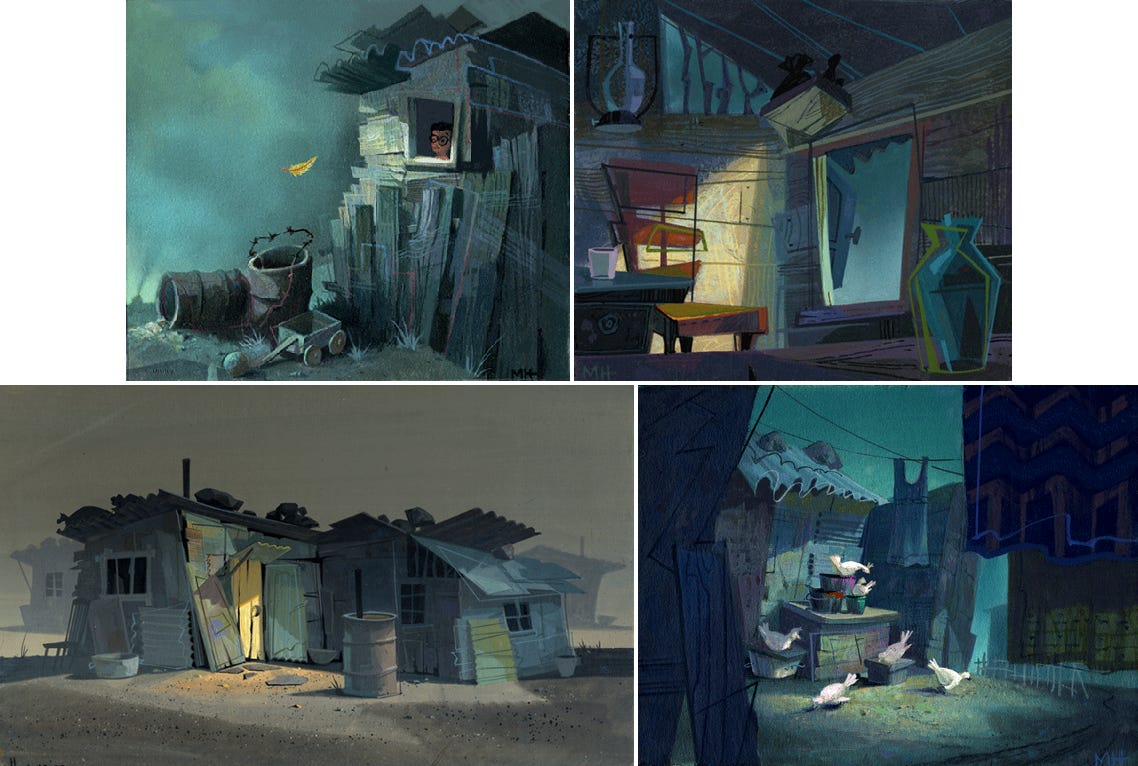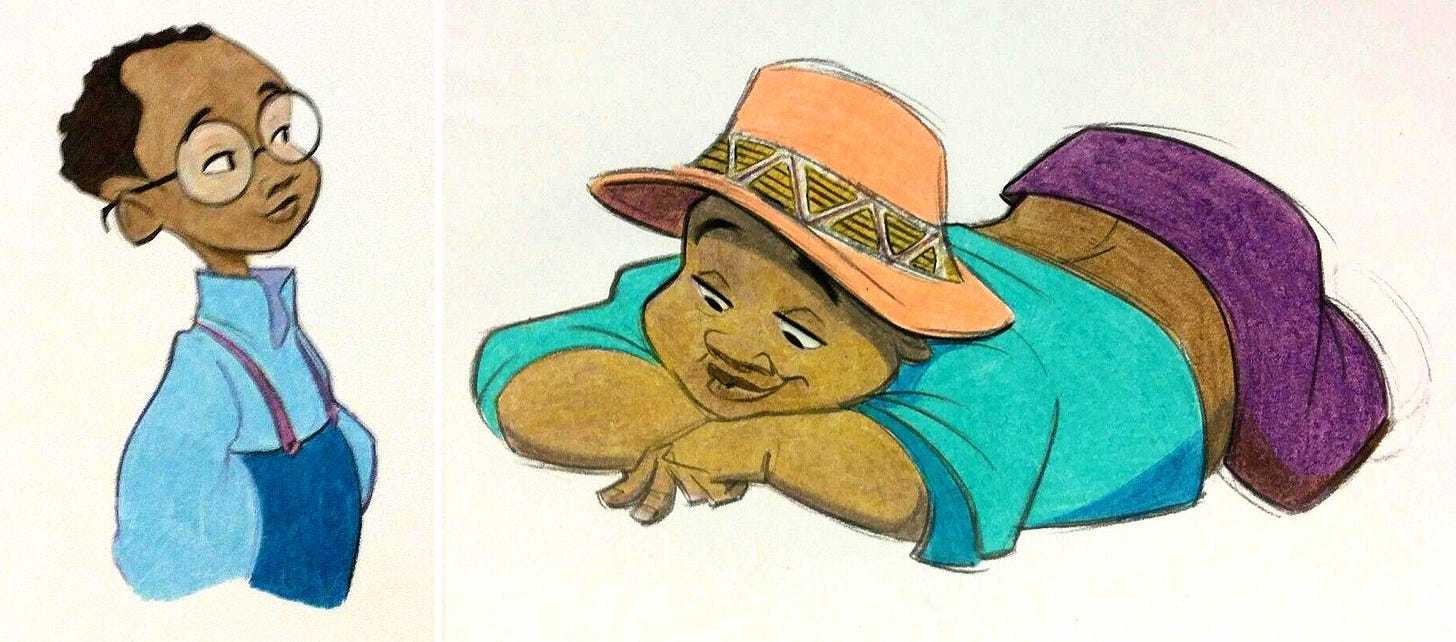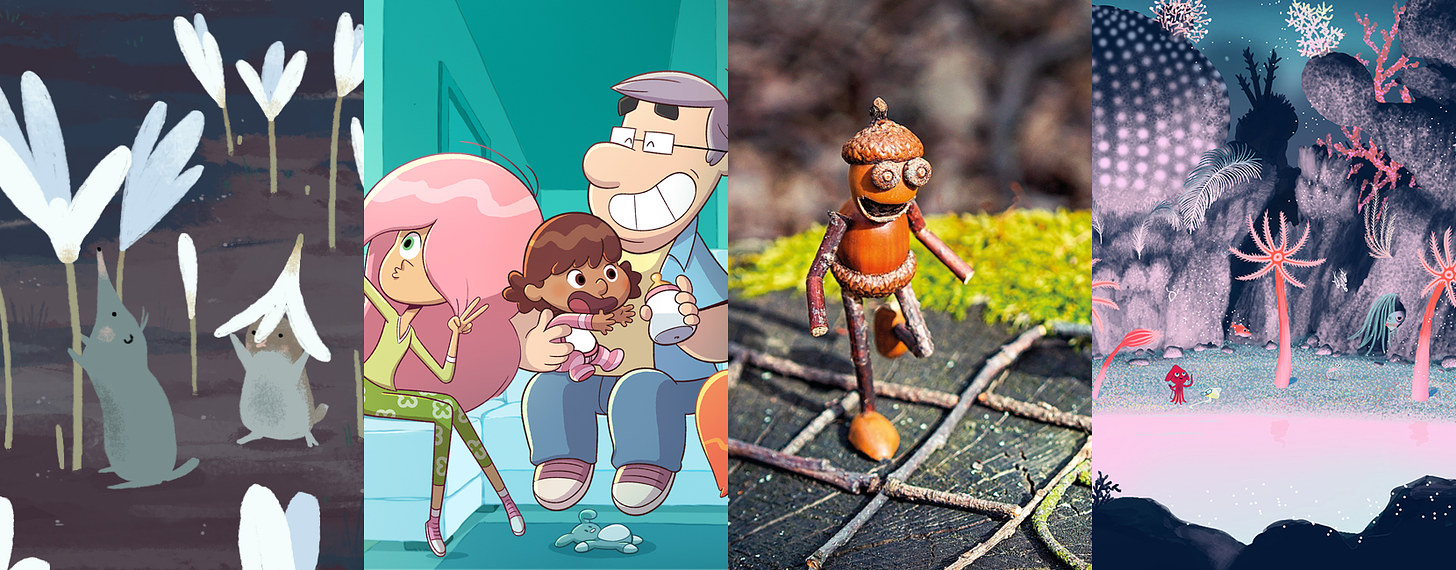Welcome to another edition of the Animation Obsessive newsletter! We’re glad you could join us. Here’s our agenda for today:
One — Disney’s modern-day classic One by One.
Two — animation news from around the world.
Three — the retro ad of the week.
Four — the last word
If you’re new to the newsletter, don’t hesitate to sign up. Catch our weekly Sunday issue in your inbox for free — it only takes a second:
Now, let’s get going!
1. The beauty of One by One
When you think of Disney animation, titles like Snow White, The Little Mermaid and Frozen come to mind. We know Disney for its hits. That’s not an accurate picture of the company, though.
Across its long history, Disney has racked up canceled projects, weird detours and out-of-the-way gems by the hundreds. They’re essential to its identity. If you leave out the story of a film like Destino, the Salvador Dalí project that took almost 60 years to finish, you miss something complex and important about Disney.
Which brings us to One by One — one of Disney’s most obscure films of the 21st century, and one of its best.

One by One is a five-minute short from 2004. It appeared, very quietly, on a special edition of The Lion King 2. Based on that origin, you’d never expect a film like this.
It’s a wordless story — we watch kids in a South African shantytown rise up, building vibrant kites. The animation and color design stand shoulder to shoulder with Disney’s boldest of the time. Driving it all is a huge, gorgeous piece of choral music in Zulu, punctuated by one line (the title) in English.
How did a film this good, and this unrelated to The Lion King 2, end up here? It started with a man named Pixote Hunt — and a song called One by One.
Hunt is a little-known figure in animation history. Bruce W. Smith (The Proud Family) has called him “one of the underrated greats in this biz.” After working off-and-on at Disney since the ‘80s, Hunt landed a director slot on Fantasia 2000. This made him, as Animation World Network noted, “Disney’s only African-American director.”
After Fantasia 2000, Hunt quickly found himself on the next entry in the Fantasia series. Internally, it was called Fantasia 2006. Whether it would be a full sequel was up in the air. One idea was to remix Fantasia 2000, rotating in new shorts over time. Whatever the project was, though, it would focus on world music.
“And Pixote came up with this idea based on some music from The Lion King,” producer Don Hahn later said. It was a song by Lebo M, the South African singer whose cry of nants ingonyama had kicked off that film.

Lebo M had brought the weight of lived experience to his music for The Lion King. A child of apartheid, he’d fled South Africa at 14 to avoid political imprisonment. All of that shows up in his work at Disney. “I associated Mufasa with Mandela,” he later said, “and I associated Simba with myself.”1
Hunt decided to make a film out of Lebo M’s song One by One. It wasn’t in The Lion King itself — it had debuted on the album Rhythm of the Pride Lands, the 1995 “sequel” to the Lion King soundtrack. From there, the song had jumped to the Lion King musical, in which Lebo M was a key player. One by One arrives at the midpoint, during a sequence where the performers dance with kites. This visual would power Hunt’s film.
Like all of Lebo M’s Lion King songs, One by One is deeply South African. Its call-and-response, a cappella sound is one he’d internalized at a young age. As he put it:
Much of our music was inspired many years ago by workers in the gold mines. […] These people created music that was inspired by their hardships, and they inspired each other through their music. Competitions of a cappella choirs started occurring within those compounds. When I was three, four years old, my father used to take me to where the mine workers lived, because every weekend there were competitions from seven in the morning until ten at night, 200 choirs, great music and singing and dancing.
As the film revved up, Hunt traveled to South Africa for research. A top-tier team came together at Disney, much of it fresh off feature films. Tony Bancroft, co-director of Mulan, dove into animation supervision for Hunt’s project after finishing up The Emperor’s New Groove. Bruce W. Smith worked on the character designs. The Paris and Burbank feature divisions both got involved.
One by One was intended for IMAX — and its look pushed Disney’s tech past its limit. Co-director Dave Bossert, who oversaw the beautiful kites and other computer effects, said that Disney’s famous CAPS system couldn’t handle the film. It had to be upgraded mid-production.
Then there was the new version of Lebo M’s song, built out of sessions with several choirs in South Africa and the United States. Lebo M himself performed the lead vocal part. The result is more powerful than ever — and, when combined with Hunt’s visuals, the meaning of its lyrics becomes crystal clear. The song is a Zulu-language anthem of Black power and resistance toward apartheid:2
Hold on tight, my people / Don’t get weary / Don’t lose your strength / We can see / They wanted to hold us back / One by one / They will not succeed / One by one / We will win / One by one / They will not succeed / One by one / We will win / Because / We know who we are / Come and see / The cowards are running away / The color of my skin / That is dark / I’m proud of it / I will die with it / I’m proud of it / Oh, yes / It’s beautiful in Africa
You could argue that this makes One by One Disney’s most radical film of this century. It’s a shame, then, that so few people saw it.
The third Fantasia project eventually dried up between 2003 and 2004. It was a casualty of Disney’s wider effort to shrink its 2D feature animation presence. The films produced for it (Lorenzo, Destino, The Little Matchgirl, One by One) were scattered. Destino and Lorenzo ended up getting Oscar nominations — and a number of major re-releases. One by One wasn’t so lucky.
Even now, you’ll only find Hunt’s film attached to The Lion King 2. And yet his and Lebo M’s beautiful vision still feels relevant. The execution is fresh. The message is more audacious than any Disney would manage until at least Black Panther. After all these years, One by One has held up the best of any Fantasia 2006 film.
If you have five minutes to spare, the whole thing is available on YouTube. It’s unquestionably worth your time.
2. News around the world
Soyuzmultfilm plans features and more
The ongoing quest to make Russian culture competitive with imports is working — sort of. This week, a report showed that around 60% of the country prefers domestic cinema. The long game is less certain. Among respondents aged 18–24, more than three-fourths say that they like American films better.
One key to closing this culture gap, or at least shoring up the kids’ market, may be Soyuzmultfilm in Moscow. Since we started covering the news in February, we haven’t seen an animation studio anywhere in the world move as fast as Soyuzmultfilm has this year. With the support of the government, the company is rapidly trying to position itself as Russia’s Disney.
That continued this week. On Monday, Soyuzmultfilm revealed plans to turn its series Prostokvashino (literally, “soured milk”) into a feature film. Adapted from a Soviet-era film series, the show is arguably Soyuzmultfilm’s most successful attempt to mine its back catalog. On the Russian TV channels Carousel and Mult, Prostokvashino was a top-three show among viewers aged 7–10 during the first half of 2021.
That isn’t the studio’s only feature film in the works, either. It’s shopping for buyers today for two in-production features, The Golden Beehive and The Formula of Water, at the Toronto International Film Festival.
If that wasn’t enough, Soyuzmultfilm also said Monday that the Soviet-era series Well, Just You Wait! would return by the end of 2021. (The 3D reboot, premiering with a first season of 52 episodes, has been teased since last year.) And, in a Thursday bulletin, the studio announced a program to retrain writers into the art of the animated screenplay — with an eye toward staffing up for more features and TV series.
Although Soyuzmultfilm makes a lot of noise in Russia, it’s worth remembering that its competitors are still ahead in key ways. Animaccord just clocked in 100 billion views of its Masha and the Bear series on YouTube. Per Licensing Market News, that studio recently landed on License Global’s annual list of the top 50 licensors — the only Russian company to do so.
Pitch season approaches at Cartoon Forum
Cartoon Forum is coming. The event, which Animation World Network recently called “one of the industry’s most important annual pitching and co-production conferences for animated TV projects,” will feature 84 series this year.
Taking place in Toulouse, Cartoon Forum is leaning local — 33 of the shows are French, per Variety. That includes Living with Dad, one of the many projects based on French comics at the event. Ireland takes second place with 11 entries, the only other country in the double digits. There’s also a special “Spotlight on Portugal,” which is bringing five.
We’ll be following up on Cartoon Forum later this month, once it wraps on September 23. Until then, you can find the full list of projects, including screenshots and details, on the official site.
Best of the rest
The second season of Kid Cosmic, Craig McCracken’s great new show, premiered this week on Netflix.
The Nigerian publisher Comic Republic, a major superhero label in Africa, has signed with CAA. The goal? Spreading its characters worldwide in “both live-action and animation.”
Canada’s National Film Board has announced a new round of paid apprenticeships for animators. The submission deadline is October 4.
The International Emmy Kids Awards revealed its animated nominees this week. Among them are the fun-looking Tish Tash from South Korea and Petit from Chile.
Next month, the Japanese series Way of the Househusband returns to Netflix for a second season, per Anime News Network.
Also in Japan, and in collaboration with Studio Ghibli, the Niigata Prefectural Museum of Modern Art is opening a major Isao Takahata retrospective on September 18.
Recent data shows that French animation exports are booming. Animation is the country’s main TV export, with revenue growth of 110% over the last decade. The United States and Germany are its largest markets.
The Taiwanese government has dropped an intriguing new edutainment cartoon about brain science — The Brainy Giant. It’s around 50 minutes long and was produced over a year and a half. The style is very charming.
Lastly, AnimationXpress interviewed the director of Seen It, the Indian short that won at Fantasia Film Festival in August.
3. Retro ad of the week
During his heyday in 1950s advertising, John Hubley oversaw a huge number of TV ads at his studio Storyboard. Many of them, even some of the best, are poorly documented and nearly unavailable. Cow Train is one of those. We’re lucky to have it at all.
This is a spot for evaporated milk by Foremost Dairies, a long-defunct dairy company. Based on a news snippet from the time, it likely premiered in ‘55. Its main idea is a cow on wheels, skating along a train track to deliver the product. Jazz, which Hubley popularized in TV ads, plays a big role. There’s a wonderful jingle sung by Lucy Ann Polk and written by Hubley’s frequent collaborator Shorty Rogers.
Then there’s the animation. According to Cartoon Research, the artist is Rod Scribner — known for his extreme, energetic style. He reins in the chaos here, opting for movement with a sleek and effortless-looking flow. It fits right in with the jazz, and helps to make this one of Storyboard’s most rewatchable ads of the period, as seen below:
4. Last word
That’s all for this week! Thanks for sticking with us. We’ll be back next Sunday with another batch of news, lookbacks and more.
But you don’t have to wait that long. On Thursday, we’ve got one last free bonus issue for you. We’re talking to Zhou Fangyuan — the Beijing student who lit up the internet in China with her beautiful Kaleidoscope, an animated celebration of the country’s 56 ethnicities.
After that, our weekly bonus issues will be exclusive to members. (A big thank-you to everyone who’s made the jump so far!) If you’d like to keep receiving Thursday deep-dives into animation, you’ll find everything you need on our subscription page:
Students with .edu addresses are eligible for a 40% discount — just email us for the code.
One last thing. If you missed our bonus issue last Thursday, we talked to animator Jonni Phillips, who’s on an incredible journey to make a 90-minute feature film almost entirely by herself. Whether you animate or not, her story is a great read.
Hope to see you again soon!
From the book The Lion King: Pride Rock on Broadway, a source we use throughout the article.
Here, we refer to a translation by Kyle Sircus from 2011. It gels with other translations we’ve seen, but it’s easily the most complete.






